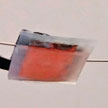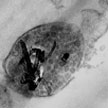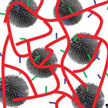Showing Spotlights 1289 - 1296 of 2875 in category All (newest first):
 Individual graphene sheets and their functionalized derivatives have been used to remove metal ions and organic pollutants from water. These graphene-based nanomaterials show quite high adsorption performance as adsorbents. However they also cause additional cost because the removal of these adsorbent materials after usage is difficult and there is the risk of secondary environmental pollution unless the nanomaterials are collected completely after usage. One solution to this problem would be the assembly of individual sheets into three-dimensional (3D) macroscopic structures which would preserve the unique properties of individual graphene sheets, and offer easy collecting and recycling after water remediation.
Individual graphene sheets and their functionalized derivatives have been used to remove metal ions and organic pollutants from water. These graphene-based nanomaterials show quite high adsorption performance as adsorbents. However they also cause additional cost because the removal of these adsorbent materials after usage is difficult and there is the risk of secondary environmental pollution unless the nanomaterials are collected completely after usage. One solution to this problem would be the assembly of individual sheets into three-dimensional (3D) macroscopic structures which would preserve the unique properties of individual graphene sheets, and offer easy collecting and recycling after water remediation.
Mar 26th, 2014
 By miniaturizing microbial fuel cells, it becomes possible to build miniature energy harvesters that could power lab-on-chip or point-of-care diagnostics devices independent of any external power source. Because micro-sized microbial fuel cells utilize less electrode area and less liquid fuel volume than their macro-sized counterparts, optimizing the electrodes and the fuel sources are the most important factors in designing a micro-sized MFC for maximum power production.
By miniaturizing microbial fuel cells, it becomes possible to build miniature energy harvesters that could power lab-on-chip or point-of-care diagnostics devices independent of any external power source. Because micro-sized microbial fuel cells utilize less electrode area and less liquid fuel volume than their macro-sized counterparts, optimizing the electrodes and the fuel sources are the most important factors in designing a micro-sized MFC for maximum power production.
Mar 24th, 2014
 Stretchable energy storage and conversion devices are key components for the fabrication of complete and independent stretchable systems. A recent review summarizes the recent progresses in the developments of stretchable power sources including supercapacitors, batteries and solar cells. It discusses representative structural and material designs to impart stretchability to the originally rigid devices and analyze advantages and drawbacks associated with the various fabrication methods. It also presents summaries of the research progresses along with future development directions.
Stretchable energy storage and conversion devices are key components for the fabrication of complete and independent stretchable systems. A recent review summarizes the recent progresses in the developments of stretchable power sources including supercapacitors, batteries and solar cells. It discusses representative structural and material designs to impart stretchability to the originally rigid devices and analyze advantages and drawbacks associated with the various fabrication methods. It also presents summaries of the research progresses along with future development directions.
Mar 20th, 2014
 Ice accumulation is not just a cost and safety problem for the airline industry and other transportation areas, together with undesired environmental impacts. Here are some examples: Transmission lines and power network towers may deform or even collapse with the burden of excess amount of ice; ice accretion on wind turbine blades can cause a production loss as much as 50% of the annual production; frost and ice accumulation in refrigerators and heat exchangers results in a decrease of heat transfer efficiency. Therefore, great efforts have been made to understand the mechanism of icing and investigations on anti-icing and deicing have been extensively carried out. Various anti-icing and deicing methods have been developed such as for instance nanocoatings and other nanostructured surfaces.
Ice accumulation is not just a cost and safety problem for the airline industry and other transportation areas, together with undesired environmental impacts. Here are some examples: Transmission lines and power network towers may deform or even collapse with the burden of excess amount of ice; ice accretion on wind turbine blades can cause a production loss as much as 50% of the annual production; frost and ice accumulation in refrigerators and heat exchangers results in a decrease of heat transfer efficiency. Therefore, great efforts have been made to understand the mechanism of icing and investigations on anti-icing and deicing have been extensively carried out. Various anti-icing and deicing methods have been developed such as for instance nanocoatings and other nanostructured surfaces.
Mar 18th, 2014
 The investigation of effects of engineered nanomaterials on endothelial cells - which form the inner lining of blood vessels - is a critical safety issue. Already, various engineered nanomaterials are being designed for biomedical applications for intravascular use and other nanomaterials may reach the vasculature as a result of occupational, environmental, or other types of exposure. Researchers have now elucidated the mechanism of cytotoxicity of carboxylated MWCNTs on cultured endothelial cells and they show a new potential way of pharmacological cytoprotection against cytotoxic effect of carboxylated MWCNTs.
The investigation of effects of engineered nanomaterials on endothelial cells - which form the inner lining of blood vessels - is a critical safety issue. Already, various engineered nanomaterials are being designed for biomedical applications for intravascular use and other nanomaterials may reach the vasculature as a result of occupational, environmental, or other types of exposure. Researchers have now elucidated the mechanism of cytotoxicity of carboxylated MWCNTs on cultured endothelial cells and they show a new potential way of pharmacological cytoprotection against cytotoxic effect of carboxylated MWCNTs.
Mar 12th, 2014
 Flexible electronics is a rising field in terms of research and potential application opportunities to obtain similar characteristics than today's prevailing rigid electronics components. In new work, researchers have demonstrated the semiconductor industry's most advanced device architecture - FinFET, a new generation of device architecture which Intel has adopted in 2011 in their microprocessors; these field effect transistors offer non-planar three-dimensional topology where the channels are vertically aligned in arrays of ultra-thin silicon fins bordered by multiple gates - in a flexible platform using only industry standard processes and keeping the advantages offered by silicon.
Flexible electronics is a rising field in terms of research and potential application opportunities to obtain similar characteristics than today's prevailing rigid electronics components. In new work, researchers have demonstrated the semiconductor industry's most advanced device architecture - FinFET, a new generation of device architecture which Intel has adopted in 2011 in their microprocessors; these field effect transistors offer non-planar three-dimensional topology where the channels are vertically aligned in arrays of ultra-thin silicon fins bordered by multiple gates - in a flexible platform using only industry standard processes and keeping the advantages offered by silicon.
Mar 11th, 2014
 If you ever had problems with the (non-removable) battery in your iPhone or iPad then you well know that the energy storage or power source is a key component in a tightly integrated electronic device. Any damage to the power source will usually result in the breakdown of the entire device, generating at best inconvenience and cost and in the worst case a safety hazard and your latest contribution to the mountains of electronic waste. A solution to this problem might now be at hand thanks to researchers in Singapore who have successfully fabricated the first mechanically and electrically self-healing supercapacitor.
If you ever had problems with the (non-removable) battery in your iPhone or iPad then you well know that the energy storage or power source is a key component in a tightly integrated electronic device. Any damage to the power source will usually result in the breakdown of the entire device, generating at best inconvenience and cost and in the worst case a safety hazard and your latest contribution to the mountains of electronic waste. A solution to this problem might now be at hand thanks to researchers in Singapore who have successfully fabricated the first mechanically and electrically self-healing supercapacitor.
Mar 10th, 2014
 Researchers report the fabrication of flexible, durable, and self-assembled graphene textile electrodes for supercapacitors using a novel wet-spinning approach of ultra large graphene oxide liquid crystals followed by heat-treatment to obtain graphene fibers. The key to producing such fibers and yarns is to preserve the large sheet size even after the reduction of GO while simultaneously maintaining a high interlayer spacing in between graphene sheets. These graphene yarns could lead the way to the realization of powerful next-generation multifunctional renewable wearable energy storage systems.
Researchers report the fabrication of flexible, durable, and self-assembled graphene textile electrodes for supercapacitors using a novel wet-spinning approach of ultra large graphene oxide liquid crystals followed by heat-treatment to obtain graphene fibers. The key to producing such fibers and yarns is to preserve the large sheet size even after the reduction of GO while simultaneously maintaining a high interlayer spacing in between graphene sheets. These graphene yarns could lead the way to the realization of powerful next-generation multifunctional renewable wearable energy storage systems.
Mar 7th, 2014
 Individual graphene sheets and their functionalized derivatives have been used to remove metal ions and organic pollutants from water. These graphene-based nanomaterials show quite high adsorption performance as adsorbents. However they also cause additional cost because the removal of these adsorbent materials after usage is difficult and there is the risk of secondary environmental pollution unless the nanomaterials are collected completely after usage. One solution to this problem would be the assembly of individual sheets into three-dimensional (3D) macroscopic structures which would preserve the unique properties of individual graphene sheets, and offer easy collecting and recycling after water remediation.
Individual graphene sheets and their functionalized derivatives have been used to remove metal ions and organic pollutants from water. These graphene-based nanomaterials show quite high adsorption performance as adsorbents. However they also cause additional cost because the removal of these adsorbent materials after usage is difficult and there is the risk of secondary environmental pollution unless the nanomaterials are collected completely after usage. One solution to this problem would be the assembly of individual sheets into three-dimensional (3D) macroscopic structures which would preserve the unique properties of individual graphene sheets, and offer easy collecting and recycling after water remediation.

 Subscribe to our Nanotechnology Spotlight feed
Subscribe to our Nanotechnology Spotlight feed





